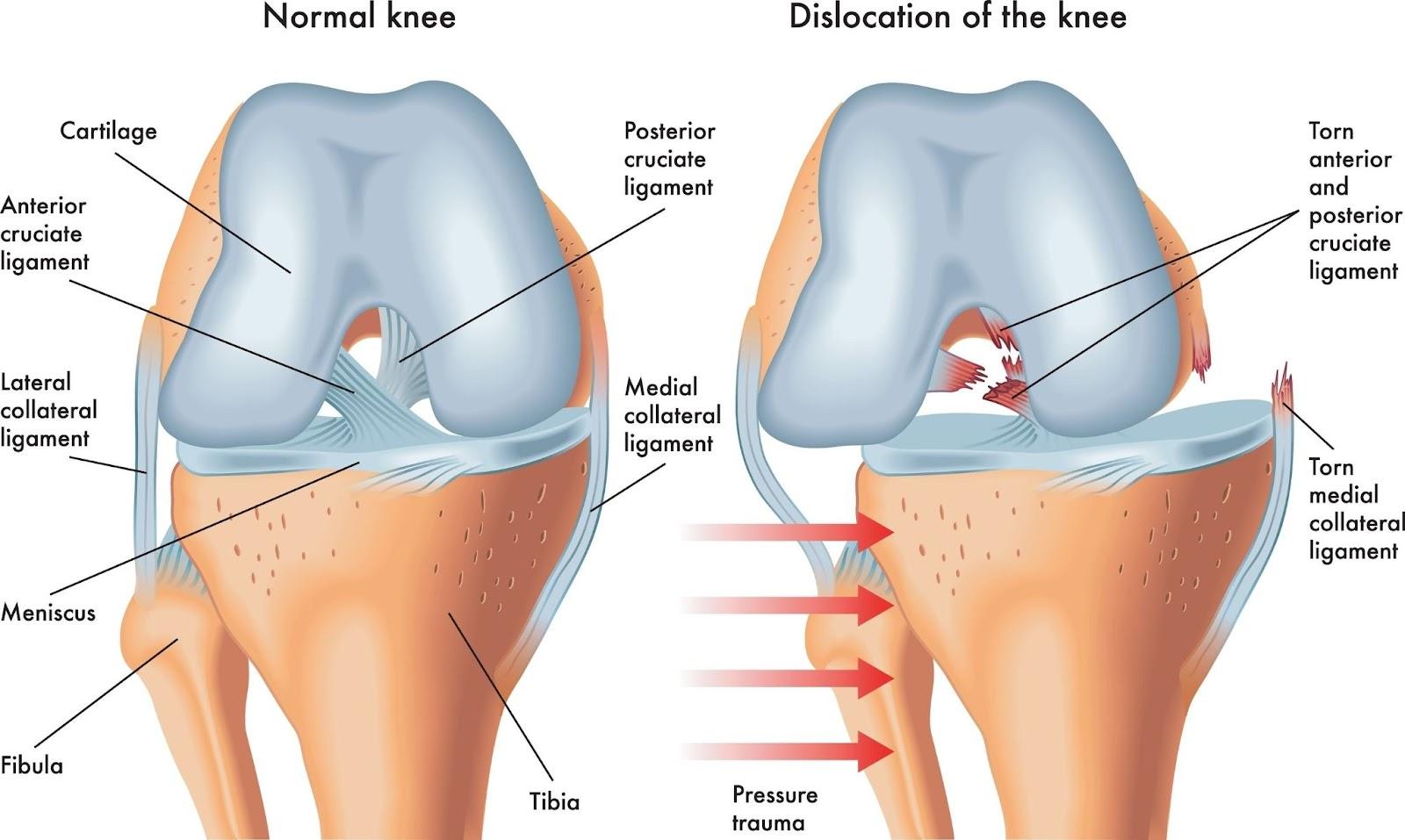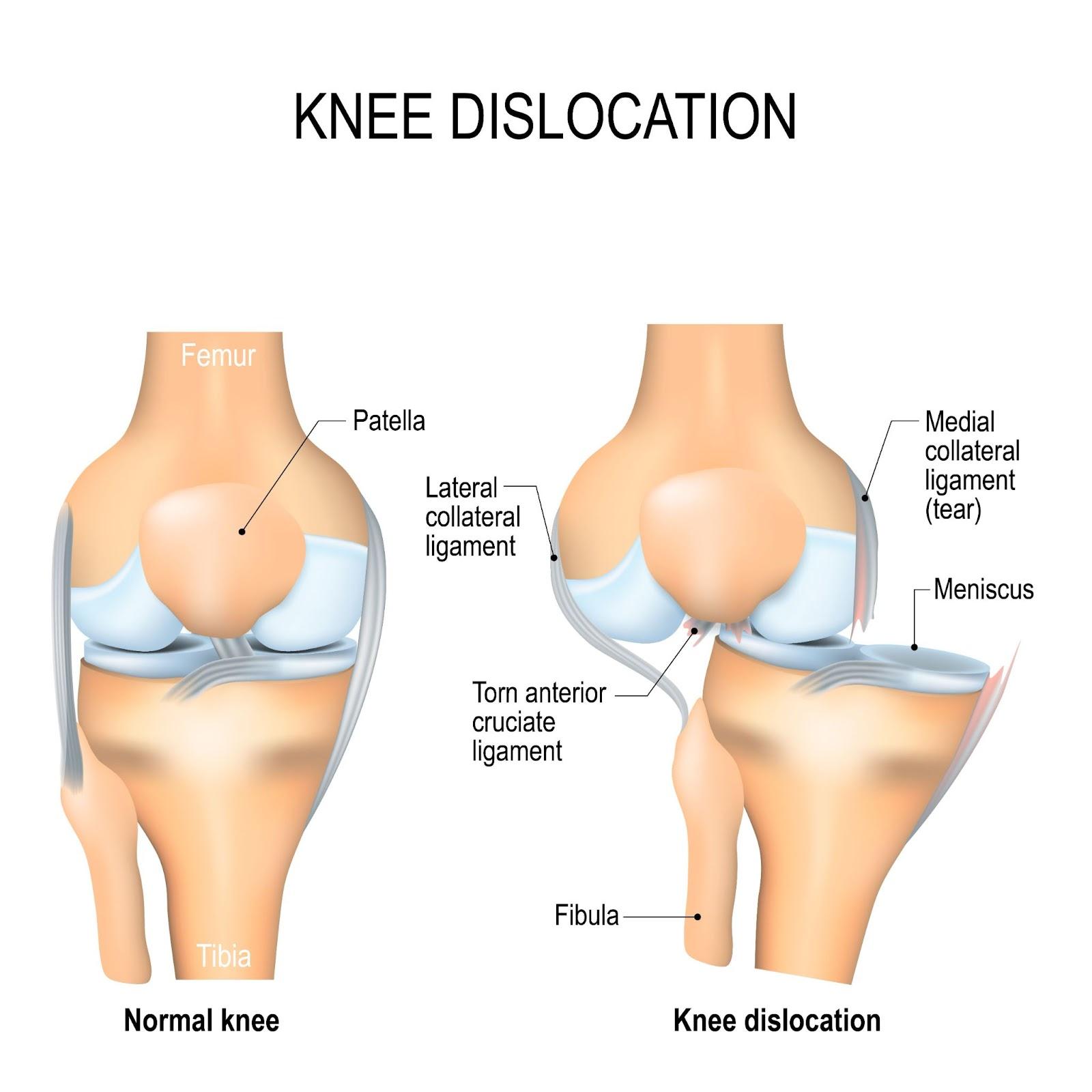Knee Dislocation

Knee dislocation causes intense pain, often making it impossible to move or bear weight, with the pain being sharp and possibly radiating to surrounding areas.
What is knee dislocation?
A knee dislocation is a severe injury in which the bones forming the knee joint—the femur (thigh bone), tibia (shin bone), and sometimes the patella (kneecap)—become dislodged from their natural alignment. This condition affects the entire knee joint and is distinct from a patellar dislocation, which involves only the kneecap.
The injury often results from a significant traumatic event, such as a car accident, a high-impact sports injury, or a fall from a considerable height. In certain situations, severe hyperextension or twisting of the knee can also lead to dislocation. These forces not only disrupt the joint’s alignment but can also damage the soft tissues, including the anterior cruciate ligament (ACL), posterior cruciate ligament (PCL), and collateral ligaments, which stabilise the knee.
A knee dislocation is considered a medical emergency, as it can lead to serious complications if not treated promptly. The injury poses a risk to nearby blood vessels and nerves, potentially resulting in impaired blood flow, numbness, or muscle weakness. Timely medical intervention is crucial to prevent long-term consequences such as chronic instability, limited mobility, or even the loss of the affected limb in extreme cases.

A knee dislocation occurs when significant trauma forces the knee joint out of alignment, damaging multiple ligaments, including ACL, PCL, MCL, and LCL, which are crucial for joint stability.
What causes knee dislocation?
A knee dislocation occurs when extreme forces disrupt the structural integrity of the knee joint, displacing the femur (thigh bone) and tibia (shin bone) from their natural alignment. The knee joint is a complex hinge-like structure stabilised by a network of ligaments, including the anterior cruciate ligament (ACL), posterior cruciate ligament (PCL), medial collateral ligament (MCL), and lateral collateral ligament (LCL). These ligaments work in harmony to maintain the joint’s stability and enable smooth motion.
A dislocation typically results from a direct, high-impact force or excessive mechanical stress—such as severe hyperextension, rotational forces, or a direct blow to the knee. When the joint is subjected to forces exceeding its structural capacity, the supporting ligaments can tear or rupture, allowing the bones to shift out of position. This displacement may also compress or damage nearby neurovascular structures, such as arteries and nerves, which highlights the critical need for immediate medical intervention.

Knee dislocation is caused by severe trauma or forceful impact that disrupts the alignment of the knee joint and damages its supporting ligaments.
What are the symptoms of knee dislocation?
A knee dislocation presents with a range of symptoms that are often immediate and severe, reflecting the extent of the injury. Below are the key symptoms explained in detail:
- Severe pain — the dislocation causes intense pain in the knee joint, often making it impossible to move or bear weight. This pain may be sharp and localised or radiate to surrounding areas.
- Visible deformity — the knee may appear visibly out of alignment or misshapen due to the bones being displaced from their normal positions. This deformity is usually a clear indication of a dislocation.
- Swelling and bruising — significant trauma to the knee leads to inflammation, which causes rapid swelling. Bruising may also develop as a result of bleeding within the soft tissues.
- Instability and inability to bear weight — the structural damage from a dislocation renders the knee unstable, which makes it difficult or impossible to support body weight or perform basic movements.
- Numbness or tingling — damage to nearby nerves during a dislocation can result in numbness, tingling, or a loss of sensation in the lower leg or foot.
- Coldness or discolouration — if blood vessels are compromised, the foot or lower leg may become cold, pale, or even bluish, indicating poor circulation that requires immediate medical attention.
Who is at risk of knee dislocation in Singapore?
Knee dislocations can affect anyone, but certain individuals are more susceptible due to specific activities or conditions. Common risk factors include:
- High-impact sports — individuals participating in contact or high-impact sports such as football, rugby, or basketball are at greater risk due to the potential for trauma or sudden twisting of the knee.
- Motor vehicle accidents — severe collisions or crashes are a leading cause of knee dislocations, as the force generated during an accident can directly impact the knee joint.
- Falls from heights — falling from a significant height can exert extreme pressure on the knee, leading to dislocation.
- Obesity — excessive body weight places additional stress on the knee joint, increasing the likelihood of injury, especially during falls or minor trauma.
- Congenital ligament laxity — individuals with naturally loose or weak ligaments are more prone to knee dislocations, as their joints may lack the stability needed to withstand external forces.
- Previous knee injuries — a history of knee injuries, including ligament tears or prior dislocations, increases the risk of re-dislocation due to compromised joint stability.
How is knee dislocation diagnosed?
At Cove Orthopaedics, we take a thorough and patient-centred approach to diagnosing knee dislocations to ensure you receive the most accurate assessment and appropriate care. Our diagnostic methods include:
- Physical examination — our team carefully examines the knee to identify visible deformities, swelling, or instability. We also assess for signs of nerve or blood vessel damage, such as numbness, tingling, or impaired circulation.
- X-rays — X-rays are performed to confirm the dislocation and determine the extent of the bone misalignment. They also help identify any fractures that may have occurred alongside the dislocation.
- Magnetic resonance imaging (MRI) — if ligament, tendon, or cartilage damage is suspected, we use MRI scans to obtain detailed images of the soft tissues around the knee joint. This allows us to create a comprehensive treatment plan according to your specific injury.
- Vascular assessment — since knee dislocations can affect blood flow, we may perform tests such as a Doppler ultrasound to check for any vascular injuries, ensuring your circulation remains intact.
- Neurological evaluation — we assess nerve function in the lower leg and foot to identify any potential nerve damage that may have occurred during the dislocation.
What are the treatment options for knee dislocation?
At Cove Orthopaedics, we understand that every patient’s knee dislocation is different, and we provide personalised treatment plans to restore your knee’s function and stability. Our treatment options include:
- Closed reduction — for many dislocations, we carefully manipulate the bones back into their proper alignment under anaesthesia to ensure your comfort during the procedure.
- Immobilisation — after reduction, we may stabilise your knee using a brace or splint to protect it during the initial healing phase and prevent further injury.
- Physical therapy — we work closely with physiotherapists to develop a rehabilitation programme focused on restoring mobility, strength, and stability to your knee.
- Surgical intervention — in cases involving severe ligament tears, blood vessel or nerve damage, or recurrent dislocations, our surgeons perform reconstructive surgery to repair or replace damaged structures.
- Vascular repair — if blood vessels are affected, we ensure prompt vascular repair to restore proper blood flow and minimise complications.
- Long-term management — we provide ongoing care and support to monitor your recovery, address any concerns, and help you return to your normal activities with confidence.
At Cove Orthopaedics, your recovery is our priority, and we are committed to guiding you through every step of the treatment process. If you suspect a knee dislocation or are experiencing symptoms, schedule a consultation with Cove Orthopaedics for expert evaluation and personalised care to get you back on your feet.
Frequently Asked Questions (FAQs)
How long does it take to recover from a dislocated knee?
Recovery time varies depending on the severity of the dislocation and the treatment approach. Generally, it can take several months to regain full function, with physical therapy playing a crucial role in rehabilitation.
Can a knee dislocation heal without surgery?
Some knee dislocations can be managed non-surgically through reduction, immobilisation, and physical therapy. However, cases involving significant ligament damage or vascular injury may require surgical intervention.
What complications can arise from a knee dislocation?
Potential complications include damage to blood vessels and nerves, chronic knee instability, reduced range of motion, and an increased risk of developing osteoarthritis in the affected joint.
Is it possible to prevent knee dislocations?
While not all knee dislocations are preventable, maintaining strong and flexible leg muscles, using proper techniques during physical activities, and wearing appropriate protective gear can reduce the risk.
What should I do immediately after a knee dislocation?
Seek emergency medical attention promptly. Avoid moving the affected leg, apply ice to reduce swelling, and keep the leg elevated while awaiting professional care.











